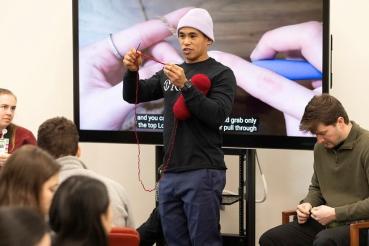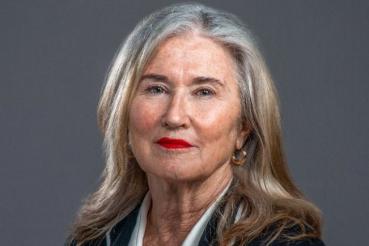Second-year Rush Medical College students Marissa Pharel and Natali Smiley were selected by the Arnold P. Gold Foundation last summer as two of 24 students named Gold Fellows, a distinction awarded annually for research in community health, cultural competency issues and improving the health and lives of traditionally underserved and at-risk populations. The recent cohort of Gold Fellows came from 10 medical schools across the United States, Israel, and Australia, and worked to execute projects focusing on underserved communities. Smiley and Pharel’s clinical research project aimed to identify why pregnant mothers from South and West Sides of Chicago may or may not seek mental health care and resources.
History and passion of students
Smiley was born and raised abroad in Turkey and moved to California as a teenager. After graduating from the University of Washington in Seattle with a bachelor’s degree in International Studies, she worked in refugee resettlement for International Rescue Committee. Smiley is passionate about working with refugees in asylum seeking communities, and volunteered abroad across Germany, Turkey and other countries. Her work in domestic resettlement has helped refugees at different stages of their resettlement process.
"I’ve learned a lot about post-traumatic stress disorder (PTSD), especially in refugee and immigrant populations, and how major difficult life transitions can cause PTSD,” Smiley explained. “Marissa and I shared this interest in understanding more about PTSD and mental health.”
Pharel, a Haitian American, was born in New York but grew up in San Juan, Puerto Rico. Her inspiration to earn two bachelor’s degrees in Psychology and Spanish from Villanova University, came partially from her father, a physician who eventually went back to school for his PsyEd. But until then, conversations surrounding mental health were not always common in Pharel’s household.
“Thinking about my parents’ experience immigrating to this country, they didn’t necessarily talk about mental health as much as they should. So, when I was older and my dad went back for his PsyEd, he shifted the tide. Eventually, I wanted to understand why that conversation was so taboo in our culture and communities, and how we could change that narrative.”
About the research study
Interestingly, Smiley explained she has come full-circle to learn from her experiences volunteering abroad to an intervention that was developed in refugee camps of eastern Europe in the 1990’s. Narrative Exposure Therapy (NET), a short-term intervention for trauma-spectrum disorders, aims to decrease the effects of PTSD, long-term, through a storytelling method that asks patients to build out their lifeline. Throughout their sessions, patients use symbolic objects in their story to represent high and low moments of their life, focusing on the “hot memory” of “rocks and stones,” or traumatic moments, to connect them to the “cold memory” of the orientation of time and space.
Natalie Stevens, PhD, assistant professor of behavioral sciences at Rush Medical College and co-director of the Center for Women’s Behavioral and Mental Health at Rush, has dedicated her research to understanding the impact of stress, trauma and anxiety on pregnancy outcomes, and has worked with NET through a trial conducted by the Rush Women’s Health Clinic.
The clinic was not achieving the number of trial participants they were anticipating, though. Here, the two medical students became curious about why more women are not seeking out interventions such as NET. They decided to contribute to the lab’s efforts by conducting a series of surveys with 44 women across Chicago to determine the reasons.
“We tried to figure out if there was mistrust of the medical system, a stigma of seeking out mental health care, or more tangible barriers to access in mental health such as transportation or childcare. Maybe women simply don’t know what resources are in their neighborhood,” Pharel explained.
Results and implications
Smiley and Pharel’s study resulted in valuable insights, such as mistrust with the medical system and a need for caution when navigating medical settings. This was measured as being higher among Black individuals relative not only to the average, but to both White non-Hispanic individuals and Hispanic individuals as well.
“That’s not so surprising given examples of medical malpractices in history against the Black community, like Henrietta Lacks or the Tuskegee Syphilis Trial,” Pharel referenced. “It makes sense we would believe caution needs to be taken.”
Self-stigma, or what the students defined as a level of internalized shame in seeking mental health care, was also measured. While Hispanics and Latinos had higher rates of self-stigma, they were also more eager to discuss mental health care and services although they were less aware of where to find them. On the other hand, Black individuals were more aware of mental health services and where to find them but less confident seeking and discussing services. This characteristic was also accounted for in comparing neighborhood attitudes. While participants from South Side had the highest measure for self-stigma in seeking mental health care, the participants from West Side, which is home to the Illinois Medical District, were much more aware of their mental health resources and comfortable seeking out services.
“Also, while the South Side was lower in awareness and comfort, it also accounted for most of our Black and Latino patients,” Pharel highlighted about the racial disproportions.
When asked about the wider conversation and impact they envisioned for their project, the students agreed that discussions in academia needed to have better reach beyond the walls of its institutions.
“Back in the spring, Marissa and I talked about the future implications of a study like this. While we are in the ivory tower of academia discussing the potential for change from one study, when it comes down to it, patients need boots on the ground, delivering care in an accessible, reasonable manner,” Smiley emphasized. “Institutions could execute more trials and clinics, and build many buildings with the latest state-of-the-art technology, but if we’re not making this all accessible to the people who need it —it doesn’t matter.”
“Hopefully, this comes across as a longitudinal project. We care about its continuity and longevity,” expressed Pharel. “Though the Gold Fellowship timeline has ended, our passion and drive to get this work moving has not stopped.”




